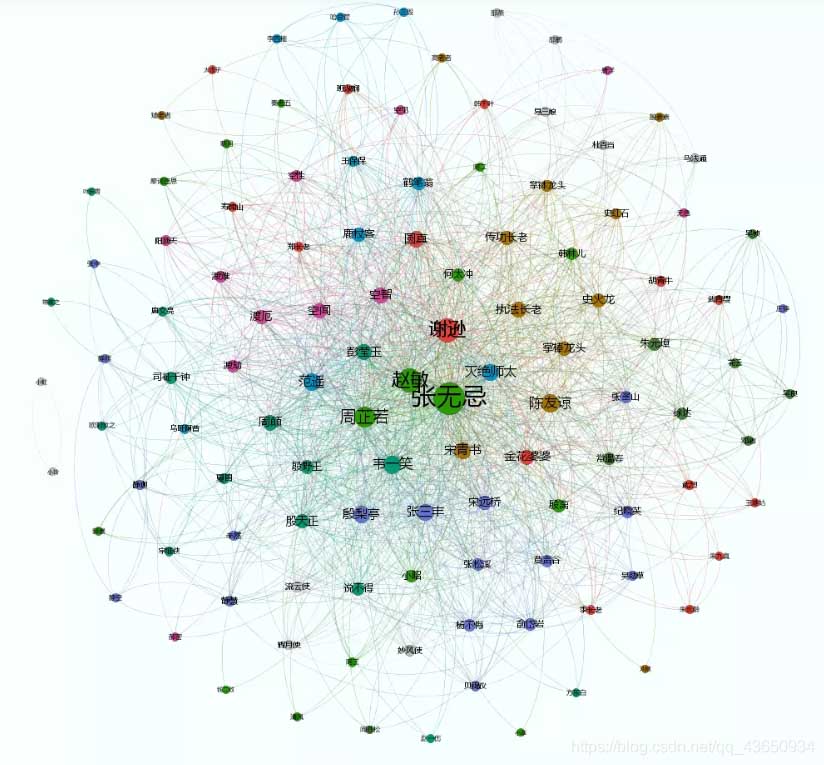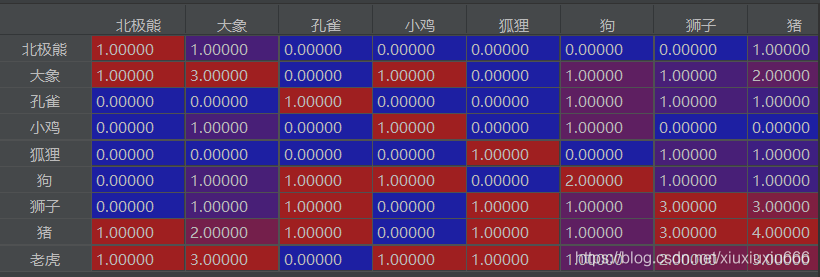python共现矩阵实现
最近在学习python词库的可视化,其中有一个依据共现矩阵制作的可视化,感觉十分炫酷,便以此复刻。

项目背景
本人利用爬虫获取各大博客网站的文章,在进行jieba分词,得到每篇文章的关键词,对这些关键词进行共现矩阵的可视化。
什么是共现矩阵
比如我们有两句话:
ls = ['我永远喜欢三上悠亚', '三上悠亚又出新作了']
在jieba分词下我们可以得到如下效果:

我们就可以构建一个以关键词的共现矩阵:
['', '我', '永远', '喜欢', '三上', '悠亚', '又', '出', '新作', '了'] ['我', 0, 1, 1, 1, 1, 0, 0, 0, 0] ['永远', 1, 0, 1, 1, 1, 0, 0, 0, 0] ['喜欢' 1, 1, 0, 1, 1, 0, 0, 0, 0] ['三上', 1, 1, 1, 0, 1, 1, 1, 1, 1] ['悠亚', 1, 1, 1, 1, 0, 1, 1, 1, 1] ['又', 0, 0, 0, 1, 1, 0, 1, 1, 1] ['出', 0, 0, 0, 1, 1, 1, 0, 1, 1] ['新作', 0, 0, 0, 1, 1, 1, 1, 0, 1] ['了', 0, 0, 0, 1, 1, 1, 1, 1, 0]]
解释一下,“我永远喜欢三上悠亚”,这一句话中,“我”和“永远”共同出现了一次,在共现矩阵对应的[ i ] [ j ]和[ j ][ i ]上+1,并依次类推。
基于这个原因,我们可以发现,共现矩阵的特点是:
- 共现矩阵的[0][0]为空。
- 共现矩阵的第一行第一列是关键词。
- 对角线全为0。
- 共现矩阵其实是一个对称矩阵。
当然,在实际的操作中,这些关键词是需要经过清洗的,这样的可视化才干净。
共现矩阵的构建思路
- 每篇文章关键词的二维数组data_array。
- 所有关键词的集合set_word。
- 建立关键词长度+1的矩阵matrix。
- 赋值矩阵的第一行与第一列为关键词。
- 设置矩阵对角线为0。
- 遍历formated_data,让取出的行关键词和取出的列关键词进行组合,共现则+1。
共现矩阵的代码实现
# coding:utf-8
import numpy as np
import pandas as pd
import jieba.analyse
import os
# 获取关键词
def Get_file_keywords(dir):
data_array = [] # 每篇文章关键词的二维数组
set_word = [] # 所有关键词的集合
try:
fo = open('dic_test.txt', 'w+', encoding='UTF-8')
# keywords = fo.read()
for home, dirs, files in os.walk(dir): # 遍历文件夹下的每篇文章
for filename in files:
fullname = os.path.join(home, filename)
f = open(fullname, 'r', encoding='UTF-8')
sentence = f.read()
words = " ".join(jieba.analyse.extract_tags(sentence=sentence, topK=30, withWeight=False,
allowPOS=('n'))) # TF-IDF分词
words = words.split(' ')
data_array.append(words)
for word in words:
if word not in set_word:
set_word.append(word)
set_word = list(set(set_word)) # 所有关键词的集合
return data_array, set_word
except Exception as reason:
print('出现错误:', reason)
return data_array, set_word
# 初始化矩阵
def build_matirx(set_word):
edge = len(set_word) + 1 # 建立矩阵,矩阵的高度和宽度为关键词集合的长度+1
'''matrix = np.zeros((edge, edge), dtype=str)''' # 另一种初始化方法
matrix = [['' for j in range(edge)] for i in range(edge)] # 初始化矩阵
matrix[0][1:] = np.array(set_word)
matrix = list(map(list, zip(*matrix)))
matrix[0][1:] = np.array(set_word) # 赋值矩阵的第一行与第一列
return matrix
# 计算各个关键词的共现次数
def count_matrix(matrix, formated_data):
for row in range(1, len(matrix)):
# 遍历矩阵第一行,跳过下标为0的元素
for col in range(1, len(matrix)):
# 遍历矩阵第一列,跳过下标为0的元素
# 实际上就是为了跳过matrix中下标为[0][0]的元素,因为[0][0]为空,不为关键词
if matrix[0][row] == matrix[col][0]:
# 如果取出的行关键词和取出的列关键词相同,则其对应的共现次数为0,即矩阵对角线为0
matrix[col][row] = str(0)
else:
counter = 0 # 初始化计数器
for ech in formated_data:
# 遍历格式化后的原始数据,让取出的行关键词和取出的列关键词进行组合,
# 再放到每条原始数据中查询
if matrix[0][row] in ech and matrix[col][0] in ech:
counter += 1
else:
continue
matrix[col][row] = str(counter)
return matrix
def main():
formated_data, set_word = Get_file_keywords(r'D:\untitled\test')
print(set_word)
print(formated_data)
matrix = build_matirx(set_word)
matrix = count_matrix(matrix, formated_data)
data1 = pd.DataFrame(matrix)
data1.to_csv('data.csv', index=0, columns=None, encoding='utf_8_sig')
main()
共现矩阵(共词矩阵)计算
共现矩阵(共词矩阵)
统计文本中两两词组之间共同出现的次数,以此来描述词组间的亲密度
code(我这里求的对角线元素为该字段在文本中出现的总次数):
import pandas as pd
def gx_matrix(vol_li):
# 整合一下,输入是df列,输出直接是矩阵
names = locals()
all_col0 = [] # 用来后续求所有字段的集合
for row in vol_li:
all_col0 += row
for each in row: # 对每行的元素进行处理,存在该字段字典的话,再进行后续判断,否则创造该字段字典
try:
for each1 in row: # 对已存在字典,循环该行每个元素,存在则在已有次数上加一,第一次出现创建键值对“字段:1”
try:
names['dic_' + each][each1] = names['dic_' + each][each1] + 1 # 尝试,一起出现过的话,直接加1
except:
names['dic_' + each][each1] = 1 # 没有的话,第一次加1
except:
names['dic_' + each] = dict.fromkeys(row, 1) # 字段首次出现,创造字典
# 根据生成的计数字典生成矩阵
all_col = list(set(all_col0)) # 所有的字段(所有动物的集合)
all_col.sort(reverse=False) # 给定词汇列表排序排序,为了和生成空矩阵的横向列名一致
df_final0 = pd.DataFrame(columns=all_col) # 生成空矩阵
for each in all_col: # 空矩阵中每列,存在给字段字典,转为一列存入矩阵,否则先创造全为零的字典,再填充进矩阵
try:
temp = pd.DataFrame(names['dic_' + each], index=[each])
except:
names['dic_' + each] = dict.fromkeys(all_col, 0)
temp = pd.DataFrame(names['dic_' + each], index=[each])
df_final0 = pd.concat([df_final0, temp]) # 拼接
df_final = df_final0.fillna(0)
return df_final
if __name__ == '__main__':
temp1 = ['狗', '狮子', '孔雀', '猪']
temp2 = ['大象', '狮子', '老虎', '猪']
temp3 = ['大象', '北极熊', '老虎', '猪']
temp4 = ['大象', '狗', '老虎', '小鸡']
temp5 = ['狐狸', '狮子', '老虎', '猪']
temp_all = [temp2, temp1, temp3, temp4, temp5]
vol_li = pd.Series(temp_all)
df_matrix = gx_matrix(vol_li)
print(df_matrix)
输入是整成这个样子的series

求出每个字段与各字段的出现次数的字典

最后转为df

补充一点
这里如果用大象所在列,除以大象出现的次数,比值高的,表明两者一起出现的次数多,如果这列比值中,有两个元素a和b的比值均大于0.8(也不一定是0.8啦),就是均比较高,则说明a和b和大象三个一起出现的次数多!!!
即可以求出文本中经常一起出现的词组搭配,比如这里的第二列,大象一共出现3次,与老虎出现3次,与猪出现2次,则可以推导出大象,老虎,猪一起出现的概率较高。
也可以把出现总次数拎出来,放在最后一列,则代码为:
# 计算每个字段的出现次数,并列为最后一行
df_final['all_times'] = ''
for each in df_final0.columns:
df_final['all_times'].loc[each] = df_final0.loc[each, each]
放在上述代码df_final = df_final0.fillna(0)的后面即可
结果为

我第一次放代码上来的时候中间有一块缩进错了,感谢提出问题的同学的提醒,现在是更正过的代码!!!
以上为个人经验,希望能给大家一个参考,也希望大家多多支持。





